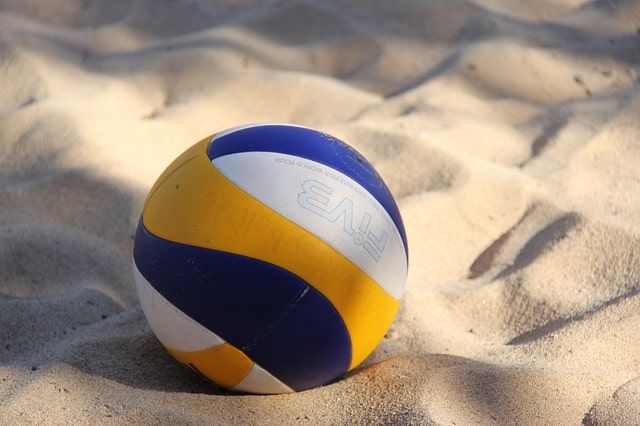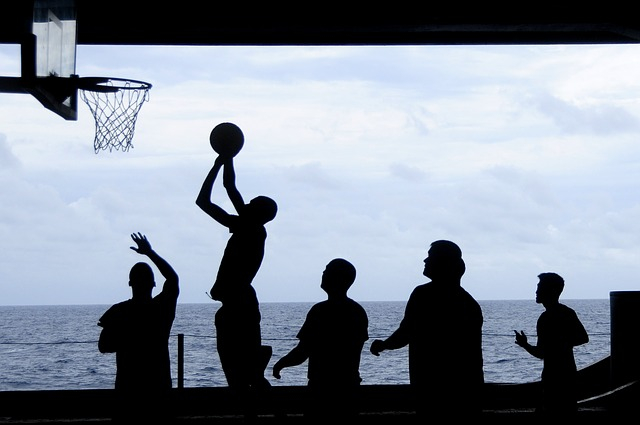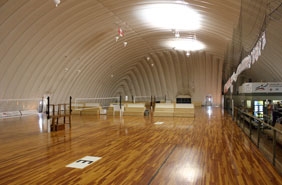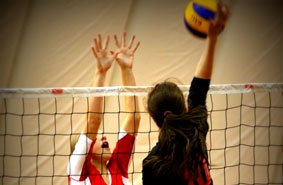
We collect basic website visitor information on this website and store it in cookies. We also utilize Google Analytics to track page view information to assist us in improving our website.
Here in the Northern Hemisphere, winter sports like skiing and ice hockey are just as beloved as field sports. But not everyone is eager to switch out the cleats for snowshoes come fall. Good news: there are plenty of awesome summer sports you probably didn’t know you could play in the winter!

1. Beach Volleyball
Who says you need a beach to play beach volleyball? Although the game may have originated as a summer pastime, it has evolved into a sanctioned Olympic sport practiced by serious athletes.
There are now indoor beach volleyball facilities (sand and all) built for year-round play. Sports domes like the Volleydome in Calgary boast courts for traditional indoor volleyball and the two-on-two beach game.
2. Soccer
A little snow on the ground isn’t enough to stop the world’s game. With the right gear, it is possible to play soccer in the wintertime.
Of course, the game changes quite a bit when the green turns to white, and not necessarily for the better. The ball skips and glides across the snowy pitch with ease but is much harder to keep in control. The low-friction playing surface also puts players at risk of injury.
Playing soccer outdoors in the cold isn’t ideal unless the season runs long or winter comes early. Fortunately, there’s an alternative: the soccer dome.
Failing that, there are plenty of soccer drills you can practice almost anywhere, with or without a soccer dome.
3. Tennis
Why play a sport associated with short shorts and miniskirts in the winter?
Because it’s surprisingly awesome.
Tennis becomes a whole different game when the temperature drops, demanding a new playstyle and tweaks to your equipment. It’s a great challenge for seasoned tennis players who want to try something new.
Just be sure to dress for the weather with a moisture-wicking base layer and lots of insulating layers on top.
4. Cycling
Believe it or not, there are lots of ways to experience the joys of cycling in the winter.
If you’re brave enough to venture outdoors, it’s possible to outfit your regular commuter bicycle to tackle the slippery roads ahead. However, it does require some extra maintenance; MEC recommends that you wipe down the chain after every ride, apply lube to the chain at least three times a month, and spray aerosol lube on all the moving parts once another.
Winter mountain biking is another option. This heart-pounding winter sport is one of the best ways to soak in the breathtaking snow-covered wilderness.
For cyclists who prefer to stay warm, there’s track cycling, a lesser-known Olympic event that provides an incredible workout and a great show for spectators. Thanks to air-supported structures like the Team USA Velodrome, you can pick up this sport at any time of year.
5. Ultimate Frisbee
It might not have made the Olympics yet, but Ultimate Frisbee has been soaring in popularity ever since its inception in the 1960s. It’s become a favourite of college students and rec leagues around North America.
Trouble is, it’s not easy to catch and throw a plastic disc with mittens on.
That’s why we’re excited to see more and more Ultimate Frisbee leagues making use of indoor facilities like sports domes. Hopefully, there will come a day when frisbee domes are as ubiquitous as soccer domes!
Soccer is an incredibly demanding sport which requires players to be in tip-top shape for optimal performance. Great soccer players do more than just train by playing one game, though. Other sports can help soccer players become better by helping to focus their skill development.
Because soccer demands so much and is so multi-faceted, narrowing down the skills you want to develop and then finding other sports or activities that hone them can really improve your performance on the soccer field!

Here are a few sports that soccer players should try out.
Tennis
We talked about how much tennis players can get out of playing soccer in this article, but it also works in the opposite direction.
Soccer players can practice changing directions quickly and anticipating the movement of the ball. No, you’re not using your feet to move the ball across the court, but the sport can still improve your ability to track the ball and anticipate trajectories.
Also, reading your opponent is a big part of tennis. In soccer, you only really get to do that in a penalty kick situation. Staring down your opponent and anticipating their reaction is something you do all the time in tennis.
Basketball
Basketball is one of the largest North American sports, so much so that it’s unlikely that you’ll see a school gym or park without a basketball court. But while the sport may look very different from soccer, some shared principles could, with practice, really improve your soccer skills.
A large part of basketball is simply moving the ball down the court. This requires fancy footwork, slick moves, and most importantly, passing. Even though you pass with your hands and not your feet, it’s the same idea. You want to look for your opening, react to it quickly, and outsmart your opponent—just like playing soccer.
Volleyball
Volleyball is a fast-paced game with a much smaller play area than soccer, but it can still work on key parts of your soccer game.
Much of volleyball is spent in the air, jumping up as high as possible to block or reach high-flying balls. Jumping and diving for the ball can help you drill down on your vertical game if you find yourself being beaten out at the net reaching for those corner kicks.
And playing beach volleyball is great for the legs—the sand is perfect for resistance training!
Swimming
Swimming might not directly help with your soccer skills, but it is an excellent activity for developing strength and endurance.
The resistance provided by the water can work your muscles to the limit faster and more effectively than on land. Swimming will improve your overall strength to help add power to your kicks, speed to your sprints, and stamina to those long run-downs.
If none of the sports above is your cup of tea, any sport you choose could have some component that is useful for soccer. It’s just such a physically demanding sport that whatever skill you decide to focus on can make a significant impact on your level of play.
The takeaway is not to pigeon-hole yourself to only playing one sport. Being well-rounded is important in sports as well as life!
The Volleydome is where up-and-coming young volleyball players become top-notch athletes. In this follow-up to last week’s post about Don and Mylene Saxton’s Volleydome, we take a look to the future at the young up and comers that cut their teeth in this volleyball dome.
Built by the Farley Group, the Volleydome has been the proving grounds for future champions for 20 years. The club’s members have gone on to compete around the world. And this year, two Volleydome alumni represented Canada at the Rio Olympic games.
Ben Saxton was born to play volleyball. His parents, Don and Mylene Saxton, are both former world champions. They founded the Canuck Stuff Volleyball Club the same year Ben was born. By age 10, Ben was already keeping up with kids who were years older than him.
Though he excelled at his parents’ sport, Ben was attracted to a different game: beach volleyball. When he was just 16, he hit the U19 World Beach Championships in France—he competed again at the age of 17 in Bermuda. That same summer, he competed with adults but found that he wasn't ready to compete at that level. Yet. Determined to do his best, Ben would persevere and continue competing with the best. In his first few years at the highest level, Ben would often travel thousands of miles to compete but lose in the first qualifying match. Despite his shaky start, Ben kept up with the competition and began to defy the odds as his skill and drive to be the best grew.
In another blow, Ben's team failed to qualify for the 2012 Olympics. But as is his nature, he renewed his determination; just as Don did when his team didn’t qualify in 1980. Ben found a new partner in Chaim Schalk and moved to California to train year round.
In 2016, he got a second chance. This year, the Saxtons were back at the Olympics as Ben represented Canada in Rio. Ben and Chaim battled to ninth place, beating the Brazilians on their home turf. And just recently, Ben and Chaim just missed the podium, placing 4th in the Beach Volleyball FIVB World Tour Finals in Toronto.
Moreover, Ben wasn’t the only Saxton scion at the Rio Olympics this year. His cousin, Graham Vigrass, played in a different court.
Fresh off earning bronze at the Pan Am Games, Graham joined the men’s indoor volleyball team. He helped Team Canada make a comeback after a 24-year Olympic hiatus. This year, the team beat out the top-ranked American and Brazilian teams and earned a fifth-place finish.
At the next games in Tokyo, there may be another Olympian with Saxton blood. Don and Mylene’s youngest daughter, Camille, has her sights set on it.
Like her brother, Camille ran around the Volleydome as a kid. By the end of high school, Camille had so many volleyball scholarships she didn’t know what to do with them. She eventually decided on Oregon State University, where she became an all-star and top 10 hitter in the conference.
After graduating, Camille followed her brother to the beach volleyball scene, where she’s already breaking ranks.
It remains to be seen which of the Canuck Club kids will have the greatest legacy. Wherever they go in their volleyball careers, Ben, Graham and Camille share roots in the Volleydome. The Farley Dome is proud to have the Saxton and Volleydome family a part of our own.
At the Volleydome, volleyball is more than just a sport – it’s a life experience.
The founders, Don and Mylene Saxton, have been involved in the world of volleyball for decades. They were once top athletes who competed at the highest levels of the game. Today, they’re busy coaching the next generation of Canadian volleyball pros at the Volleydome.
 |
Don Saxton’s journey began at the University of Saskatchewan in 1974, where he started as a varsity basketball player. Shifting gears in the fall of 1976, Don made the move to volleyball. He then went on to compete with Canada’s National Team, representing Canada on the world stage. Meanwhile, Mylene hit the courts at the University of Ottawa, making MVP in 1980. She spent a year on the Junior National Team before joining the Canadian Nationals.
That’s where Don and Mylene met. By 1983, they were married.
Volleyball has been around since the late 19th century, but volleyball only became an Olympic event in 1964. Canada first played a team at the 1976 Olympics, having qualified as the host nation, but much of Canada’s history in the sport was yet unwritten.
That changed in 1984, when Team Canada got another shot at the podium. Don helped the team qualify, for the first time in the normal process, and travelled with them to compete in Los Angeles. There, they landed a hard-fought fourth place. The fourth place finish is still the best Olympic performance in Canadian men’s volleyball.
After making a bang on the world stage, Don and Mylene turned their attention back home. They moved to Calgary and started a family. Wanting to promote the sport they love, they set to work building a club that offered the ultimate volleyball experience. In 1998, the pair founded the Canuck Stuff Volleyball Club in Calgary.
Enter the Volleydome. Built by the Farley Group 20 years ago and still standing strong, the Volleydome is Don and Mylene’s vision brought to life. The sprawling facility houses six world-class indoor volleyball courts. Under the Saxtons’ guidance, the Club’s teams have won seven Canadian Open Championships and one U.S. Open Championship.
 |
 |
|
Now, Don and Mylene are training the next generation of Canadian volleyball elites. The Club is dedicated supporting young players and fostering a life-long love of the game. Their efforts have paid off. Their youth teams have earned their way to National Youth Championship titles and dozens of Provincial Championship titles.
The future is bright for Canadian volleyball, in no small part thanks to Don and Mylene Saxton. Former Canuck Stuff kids have won volleyball scholarships and competed all over the world. A select few even made it to the 2016 Olympic Games in Rio.
That’s where Ben Saxton, Camille Saxton, and Graham Vigrass come in. Next week’s chapter will discuss Olympic experiences and dreams for this volleyball family.
